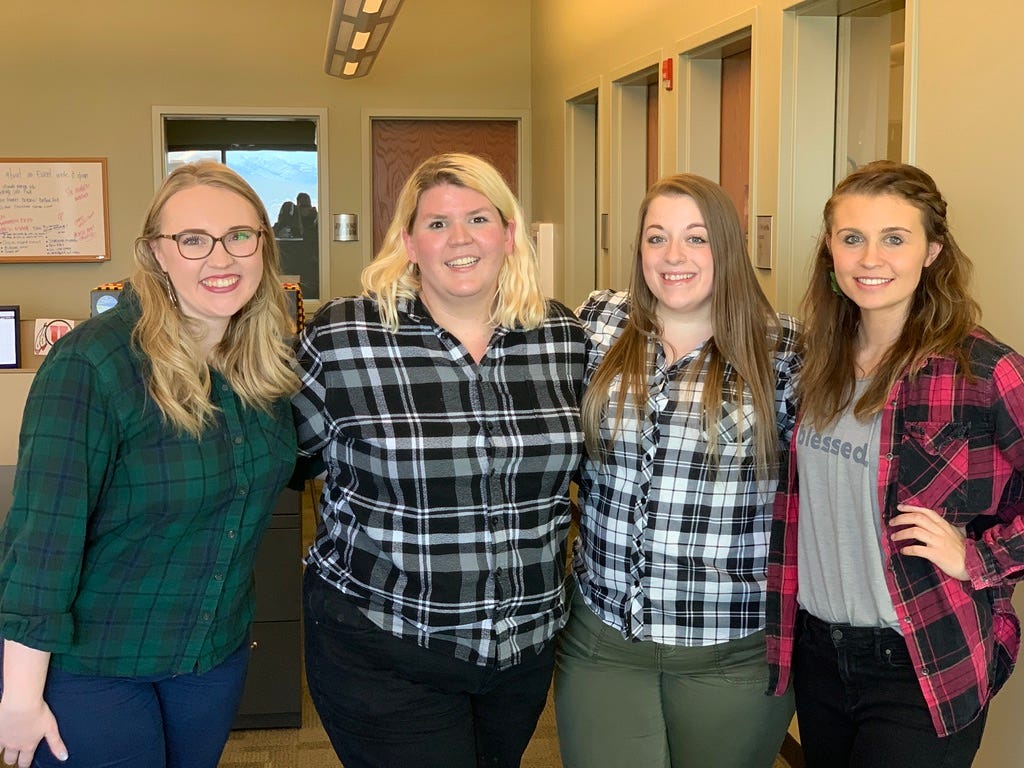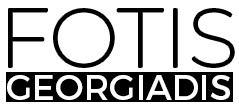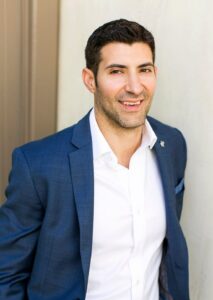Katie Sullivan Porter Of Marin Software On How to Effectively Leverage The Power of Digital Marketing, PPC, & Email to Dramatically Increase Sales
An Interview With Fotis Georgiadis
Get Gritty — I was starting a new role at a highly competitive and successful digital agency, and my 90 day review DID NOT go well. It was probably the worst feedback session I’ve ever had, and my kind but firm manager (who’s still a great friend and mentor to me today) quite simply told me I was not cutting the mustard. He encouraged I read “Grit: the Power of Passion and Perseverance” by Angela Duckworth and it completely changed my outlook on work, hustle, and being resourceful.
Marketing a product or service today is easier than ever before in history. Using platforms like Facebook ads or Google ads, a company can market their product directly to people who perfectly fit the ideal client demographic, at a very low cost. Digital Marketing tools, Pay per Click ads, and email marketing can help a company dramatically increase sales. At the same time, many companies that just start exploring with digital marketing tools often see disappointing results.
In this interview series called “How to Effectively Leverage The Power of Digital Marketing, PPC, & Email to Dramatically Increase Sales”, we are talking to marketers, advertisers, brand consultants, & digital marketing gurus who can share practical ideas from their experience about how to effectively leverage the power of digital marketing, PPC, & email.
As a part of this series, I had the pleasure of interviewing Katie Sullivan Porter.
Katie has over 12 years of experience in the marketing industry including hands on and strategic management in event marketing, paid advertising, email marketing, social media, content, influencer marketing, PR, and SEO. She spent 6 years in the agency space, and 6 years in-house with companies like Verizon, IdealFit, and most recently Marin Software. Some of the enterprise brands she’s collaborated with on omnichannel digital marketing campaigns include Shell Energy, Ascential, Cricut, and Conga. She presently oversees the digital content strategy for Marin, a global leader in paid media management software.
Thank you so much for joining us in this interview series! Before we dive in, our readers would love to “get to know you” a bit better. Can you tell us a bit about your ‘backstory’ and how you got started?
My journey into digital marketing was not a direct path by any means. I actually studied Theatre Arts Management in my undergrad, of all things, and in a roundabout way this led me into the event marketing field. I was managing trade shows and corporate events, and I found I had a real interest and passion for marketing at large, but I felt there weren’t a lot of marketers doing both traditional and digital work. Event marketers, traditional marketers, and digital marketers at that time were all still quite siloed. So I set out to become a well-rounded expert in all types of marketing. I developed my writing skills and focused on content and social media, which eventually led toward more experiences in advertising, demand gen and growth. Now I’ve done a little bit of everything, and I tend to focus on work that is truly omnichannel across digital and traditional channels.
Can you share a story about the funniest marketing mistake you made when you were first starting? Can you tell us what lessons or ‘takeaways’ you learned from that?
I had a terribly embarrassing snafu when I was working in the agency space. In order to pull some CRM reports I needed for a client, I had inadvertently connected my agency email into their CRM system. No one caught it for weeks, until the client found it directly that he had access to hundreds of agency emails. It was a bit horrifying and I was certain I was going to be fired that day. Luckily, I was working for great and understanding people who knew it was an honest human error, and they completely handled it and defended me. What I learned through that experience was that great leadership who supports their employees cannot be valued highly enough; and the devil is in the details for every single action we take as marketers.
None of us are able to achieve success without some help along the way. Is there a particular person who you are grateful towards who helped get you to where you are? Can you share a story?
When I was working for the Salt Lake Tribune as part of their digital agency, our VP Kelly Roberts had been in the newspaper business for many, many years. He knew the power of advertising and to him whether it was print, email, digital ads, or a billboard…what was most important was the message. He knew the power of a headline, and for Kelly…the right message to the right person at the right time was all that mattered. Learning that under him was a great training for me of what makes up any kind of impactful marketing.
What do you think makes your company stand out? Can you share a story?
While I’m relatively knew to Marin Software, I can already say with confidence they are a company that has exceptionally high standards of quality. I am surrounded by professionals with incredibly impressive backgrounds and education, multiple decades of experience in digital marketing, and a constant culture of improvement. The MarinOne tool has been built and continues to be improved by some of the best marketers and software engineers I have ever seen. Our CMO Wesley MacLaggan’s recurring catchphrase is, “How can we do this same thing…but make it even better?”
You are a successful business leader. Which three character traits do you think were most instrumental to your success? Can you please share a story or example for each?
Hunger for Learning — As far back as I can remember, a thirst for knowledge has defined my progress in any setting. I remember someone asking me in college, “When do you plan to graduate?” And I responded by saying, “I’m not sure it matters because I plan to be learning my whole life long.” While I did eventually graduate, my curiosity for learning has never stopped. And I think my constant curiosity has brought me a great deal of success.
Collaborative Spirit — I was running the influencer marketing program at IdealFit, a fitness supplement company, when I started asking peers in other departments to give me cross-training on their jobs. One colleague was stunned by this as the culture of the company was to keep channels fairly siloed and he asked me, “Why do you keep doing this?” And to me it was quite simple…I wanted to understand what each person does to the best of my ability so I could be a better teammate. This started a bigger conversation within the company that led to a more formal cross-training program. It was a great feeling to see my peers open up about their future goals simply because I was brave enough to ask.
Willingness to Fail — Finally, I have always approached business with a “Why not me?” kind of attitude. I know there is risk every time I try something I’ve never done before, but to me that is part of the challenge and excitement of being a marketer. We get to solve complex jigsaw puzzles with creative answers every single day. My first full-time position in digital marketing comes to mind. I was working for a Verizon retailer that had never run regional events before. I was willing to say, “Let’s try it and see what happens.” We ended up growing that program to be over 125 events each year because it was such a successful approach for our target demo.
Are you working on any exciting new projects now? How do you think that will help people?
Marin is currently in the process of adding several very innovative features to the MarinOne tool, as well as improving the existing features we already have. There are sophisticated solutions to help advertisers save hours of time, take shortcuts that make sense, and automate a vast majority of their campaign management. I believe that great marketing leads to a winning company, and winning companies then have the means to support happy and successful people. There is something so satisfying to see our tool help businesses grow and how that benefits our clients. Many advertisers we work with say since using Marin they have a better work/life balance, they’re reaching their business goals, and they feel successful in their individual roles.
Ok super. Now let’s jump to the main questions of our interview. As we mentioned in the beginning, sometimes companies that just start exploring with digital marketing tools like PPC campaigns often see disappointing results. In your opinion, what are a few of the biggest mistakes companies make when they first start out with digital marketing? If you can, please share an example for each.
I was working with a prominent crafting company that had a great deal of notoriety in their space and strong brand equity, but they were not optimizing their paid media strategy properly. There was very little audience segmentation, custom messaging, or unique creative going on. By identifying data-driven buyer personas, creating unique messages for each persona, and then making fun and exciting creative assets to capture those personas…we were able to more effectively bring in thousands of new customers for them while nurturing existing prospects down and through the funnel. We ultimately multiplied their paid media spend by 10x that year because it was producing great returns.
If you could break down a very successful digital marketing campaign into a “blueprint”, what would that blueprint look like? Please share some stories or examples of your ideas.
- Use data or research to identify your core audience. So many marketers take their best guess or go off of a “hunch” as to what their target demo wants, and I have found that when true data analysis or market research takes place…the marketer often was way off the mark. Don’t guess, let the customer tell you what they want.
- Hone in on the channels that will meet your core audience where they are, and don’t be afraid to experiment. There is no one right answer when it comes to determining the right mix of channels and tactics for a campaign. When I was working with a professional climbing equipment company, they were certain influencer marketing was not going to work for their business. There was a stigma that professional climbers only use the products they’ve been using for decades, and marketing in their industry was all word of mouth. By convincing them that influencer marketing was in essence digital word of mouth, through trusted testimonials and authentic first-person experiences, we were able to run a test pilot of relevant influencer partnerships. With just 15 great influencer collaborations, we increased their social media followers and engagement over 25% in six months.
- Take care when developing messaging and aesthetics. Your creative assets matter. I was helping an HRIS company with their website. After an expensive and much-needed rebrand as well as website update, after seeing months of lagging organic numbers, their organic traffic increased 50% in just one month and has progressively grown every month since. The first impression new prospects had been getting before that update simply was not professional. Their customer service and work was top notch, but the exterior was not reflecting the interior. By investing in the “cover” of their brand book, the company has seen immense growth.
- If things aren’t working, it’s okay to start over or completely change direction. Some marketers get really focused on what “they’ve seen work in the past.” While experience is valuable, the reality is every day in marketing is not like the last. Sure you may have used such-and-such tactic that worked great a year ago, but it may not be working now due to a multitude of reasons that are happening right now. Never stop testing. And look at all the factors in front of you. Is your audience segment still relevant? Are you saying the right things based on industry or societal challenges taking place today? Is there some part of your customer journey that was working before and is now broken? Step back, take a breath, and don’t sit on your laurels of what “should” be working.
Let’s talk about Pay Per Click Marketing (PPC) for a bit. In your opinion which PPC platform produces the best results to increase sales?
While Google Ads is by far the leading PPC option for search marketers, I have also seen great success with Microsoft Advertising and Apple Search Ads. If paid search is the driving tactic, do not underestimate the value of having a multi-channel approach. Test several audience sets on multiple platforms at once. If we’re talking PPC for social, TikTok is definitely leading the charge this year for e-commerce brands…but Instagram, Snapchat, Facebook, and Pinterest are all still doing really impactful things to drive traffic and sales. Lifestyle products particularly should have an on-point strategy for every visually driven advertising platform.
Can you please share 3 things that you need to know to run a highly successful PPC campaign?
Audience segmentation, bidding, and content marketing. The only way to be truly successful in PPC advertising is to get the right content at the right price to the right person. If one of those factors is off, you will not see conversions.
Let’s now talk about email marketing for a bit. In your opinion, what are the 3 things that you need to know to run a highly successful email marketing campaign that increases sales?
Email marketers have to delicately handle the most personal bridge marketers have to a potential customer. The precious resource that is an email address must be handled with respect and care. The best email marketers I know understand this and focus on 3 things: content, design, and user experience.
Email experts must be great content marketers that understand what the most important messages are in order to justify a recipient receiving said message direct to their inbox. They also need to be skilled at identifying what messages ought to be weeded out. Email is the time to feature the “cream of the crop” amongst the content your company has to offer.
Great email marketers also have a keen eye for design and they know how to edit. Cluttered or overly complicated emails produce very little in terms of actions. The right email guides a user through a thought process, without taking an excessive amount of time to read and without getting too complicated.
And finally user experience…email UX is not only important in every email that a contact receives, but it’s also crucial to understand the contact’s complete journey with your company emails. If drip campaigns are not set up correctly, automated actions fire improperly, or audiences are not segmented as they should be, the result can be catastrophic for your brand. If users are receiving too many emails, the wrong kinds of emails, or are getting stuck in an endless loop of content that is not relevant to them, there can be a quite damaging effect to your unsubscribe rate but also to your brand reputation.
What are the other digital marketing tools that you are passionate about? If you can, can you share with our readers what they are and how to best leverage them?
I have always been a huge proponent of connecting the digital experience to an in-person experience. Tools like Cvent, Momice, or Akkroo assist greatly in managing in-person events and automating as much of the end-to-end digital process as possible. Services like Sendoso, Goody, and Postal make personalized gift giving easy and directly integrated into your sales and nurture pipeline. Any time a digital connection with your brand can translate into an IRL memory, I’m all about it.

Here is the main question of our series. Can you please tell us the 5 things you need to create a highly successful career as a digital marketer? Can you please share a story or example for each?
Get Gritty — I was starting a new role at a highly competitive and successful digital agency, and my 90 day review DID NOT go well. It was probably the worst feedback session I’ve ever had, and my kind but firm manager (who’s still a great friend and mentor to me today) quite simply told me I was not cutting the mustard. He encouraged I read “Grit: the Power of Passion and Perseverance” by Angela Duckworth and it completely changed my outlook on work, hustle, and being resourceful.
Focus on Organization — Marketing is interesting as there are many, many approaches and none of them are “wrong” per se, but some methods of working are certainly easier than others. Save yourself a lot of headache and heartache by making things clean, organized, and simple whenever possible. With so many different types of contributors working on a single marketing project — left-brained, right-brained, creative, analytical — it is very easy to get lost in the process of how to do something and never get anywhere because everyone has a different approach. Let your campaign objective be the guiding North Star keeping everyone aligned, and divide tasks clearly so each person can do things how they’d like on their own, as long as they bring back the result the group as a whole agreed upon. Striking the right balance between autonomy and teamwork will help you arrive at the best possible final product.
Have Empathy — Regardless of what kind of marketing you’re doing, the key to reaching your audience is by recognizing and understanding what they need. If you don’t yet have the skill of empathizing or at least sympathizing with perspectives outside your own, you’ll never be very successful at marketing to people who aren’t just like you. And that makes for a pretty small target demo. I learned this firsthand when I led the rebrand of an alcohol subscription box company. The brand voice was dark, moody, manly, and masculine…and I don’t really consider myself any of those things. I had to get deep in the weeds on my research to understand what would resonate with this audience group that was so distinctively different than myself.
Be Proactive — For the first few years of my career, I got caught in the cycle of being a ticket taker. “We need a blog post.” “Draft an email.” “Come up with something for this radio ad.” I was simply receiving requests from those around me, but I was missing the big picture on how all the pieces were coming together and how they should come together. When it started to click for me that my peers were looking for collaboration as much as deliverables, my professional trajectory started to take off. I learned that thinking ahead, imagining what the end result could be, and building the framework backwards from there can be a game changer in how others perceive you professionally, how you perceive yourself, and how successful the results of your efforts are.
When in Doubt, Don’t Sell…Tell a Story. In order to be memorable, creativity is just as important as any technical or strategic skill. A storyteller can tell a marketing strategy that will engage an audience instead of just giving them more data. Figure out what your unique “take” on a conversation is and drive that perspective home with your audience through real testimonials and stories.
What books, podcasts, videos or other resources do you use to sharpen your marketing skills?
I’m a bit old school in this way as I personally can still never get enough blogs or written content. I’m a very visual learner, so reading about new ideas, seeing imagery conveying facts and figures, really helps cement those ideas in my brain and helps me retain the information. Some of my favorites are:
https://www.socialmediaexaminer.com/
https://www.searchenginejournal.com/
https://www.forrester.com/bold
https://www.insiderintelligence.com/
Thank you for all of that. We are nearly done. Here is our final ‘meaty’ question. You are a person of great influence. If you could start a movement that would bring the most amount of good to the most amount of people, what would that be? You never know what your idea can trigger. 🙂
For some time now, I have felt that losing close, supportive, local communities is one of the greatest threats to modern society. With all the good that a global economy and instant global communication has brought us, it also has de-emphasized the importance of nearby, in-person community for many people. I am always looking for ways to help people connect with their neighbors or become more involved with their local community. For me, this takes the shape of volunteering at my kids’ school, getting involved with local performing arts groups, and enjoying all the local festivals, concerts, and community events I can.
How can our readers further follow your work?
I engage with others most on LinkedIn @ https://www.linkedin.com/in/katie-sullivan-porter/ or catch some of my writing on marinsoftware.com
This was very inspiring. Thank you so much for the time you spent with this!
Katie Sullivan Porter Of Marin Software On How to Effectively Leverage The Power of Digital… was originally published in Authority Magazine on Medium, where people are continuing the conversation by highlighting and responding to this story.



